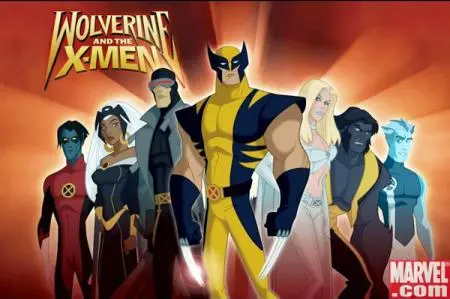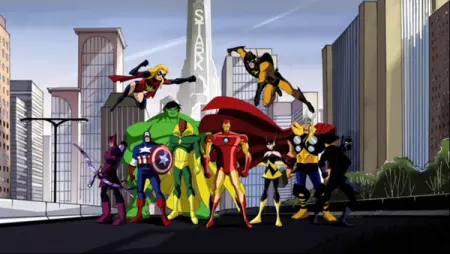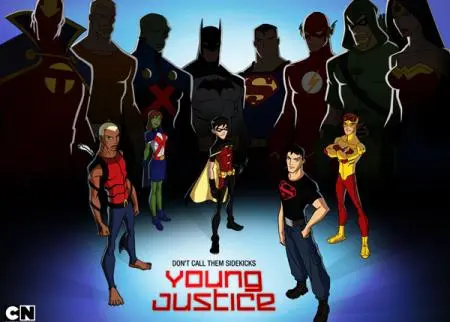It’s a hard truth for writers (and likely artists of all kinds) that sometimes your work will fail. It either won’t be what you envisioned, or it won’t find an audience, or both. Most of the time it will be your fault, and you can always take solace when you look back on it later and realize you will never make that mistake again. But sometimes your best, most brilliant and polished work will fail for reasons you never expected that are entirely beyond your control. Even people producing some of the most well-received versions of the most popular intellectual properties in the world have had their good works unceremoniously stopped despite doing everything right. What follows is a list of five exceptional superhero cartoons that could have been the next big thing if only they hadn’t been canceled in their prime.
'Fantastic Four: World’s Greatest Heroes' (2006-2007)
The awesome, doomed show:
Although it was based on Fox’s horrid 2005 movie, this orphan of the Cartoon Network was the whimsical and fun sci-fi action comedy its predecessor so desperately wanted to be. Unlike almost every superhero adaptation in the history of ever, WGH skipped a tedious retelling of the heroes’ origin and jumped straight into the sci-fi adventures. In the very first episode, the Human Torch is kidnapped and forced to stand trial for his crimes against an alien empire, with almost zero exposition. Welcome to the deep end. The stories were also mostly original, rather than direct adaptations of the comic books. While watching the domestic squabbles of people with superpowers can certainly be funny, they didn’t try to make an entire show out of it, unlike the dull one-note movies. WGH was funny, family-friendly, and delivered all of the sci-fi action one would rightly expect in a Saturday morning cartoon. Sometimes you just want to see the Thing clobber an army of robots, or gape in awe as Reed Richards explains exactly what his new science machine does, and it all looked beautiful in an anime-inspired style that was new for Marvel at the time.
Best episode:
Number 11: “Impossible.” A deep space probe returns to Earth with an alien stowaway that can do or be anything it wants, in defiance of all the laws of physics. Hilarity ensues while the FF babysit a being with the power of a god and the mind of a seven year old.
Why? WHY?!
Twenty-six episodes were made, but only eight were aired before it was pulled without explanation. Another nine episodes ran before the release of Rise of the Silver Surfer, but the rest never saw the light of broadcast. You can find all 26 episodes on DVD or streaming on the internet. After the commercially successful but critically reviled movies, you’d think Fox would have wanted to keep it on the air, so they could continue to capitalize on the best adaptation to come out of their license. Stranger still that despite cancelling it without warning, they have yet to replace it with anything.
'Wolverine and the X-Men' (2009)
The awesome, doomed show:
Taking its lead from what was happening in the comics at the time, this show began with the X-Men disbanded after the destruction of the school and the apparent deaths of Professor Xavier and Jean Grey. When a mutant registration bill is passed and the government starts incarcerating mutants, Wolverine goes on the road to get the band back together and round up some new recruits. Along the way we got to meet a ton of new characters that had barely been seen (if at all) in previous adaptations, and saw new sides of characters that have been tragically maligned by television for decades. This show might be the only reason future generations will know that Cyclops was not just a whiny teacher’s pet. Wolverine’s journey also seems calculated to touch as many corners of the X-World as possible in just one season, taking him from the wilds of Africa to the shores of the mutant nation Genosha, and even into a post-apocalyptic future ruled by killer robots. This show had everything you could hope for in an X-Men cartoon, and promised to keep delivering more of the same, leaving us with an epic cliffhanger for a second season that never came.
Best episode:
Number 12: “eXcessive Force.” Convinced that Mr. Sinister is holding his beloved Jean captive, Cyclops goes on an ass-kicking rampage and demolishes an entire city block just to lay eyes on the man holding his woman.
Why? WHY?!
WXM seemed to have learned well from the most successful of its predecessors, 1992’s X-Men. Its plots were loose adaptations of popular storylines from the comics, and Steve Blum is hands-down the best Wolverine voice since Cathal J. Dodd. It had better fight scenes than any of the first three movies despite the fact a children’s cartoon hero can’t stab or even seriously injure any of the bad guys. It had one of the highest-rated premieres in the history of Nickelodeon. And did I mention—season 2 was going to be the AGE OF APOCALYPSE. Anyone who has ever read an X-Men comic just drooled at that sentence. That storyline is so popular they’re even going to adapt it for the next film in the reboot-ology. So why aren’t you reading an article about how this show came to dominate Saturday morning? Because the financing fell through. A bunch of rich guys couldn’t agree on the proper way to make themselves even richer with this beloved cartoon, so they canned it.
'Green Lantern: The Animated Series' (2012-2013)
The awesome, doomed show:
Green Lantern Hal Jordan and his partner Kilowog take a ship and head to the edge of their jurisdiction to bring some law to frontier space. They do their buddy cop routine across the galaxy, hunting down Red Lanterns to find out what their beef is with the Guardians of the Universe. Although it was slow to get started, the series eventually attained that perfect blend of comedy, action, and drama you find in the very best Star Wars stories. GL:TAS turned rebel-with-a-cause Hal Jordan loose on a big, colorful universe dense with sci-fi mythology, fascinating aliens to meet, and strange worlds to explore. It was the kind of show where the heroes and villains exchanged just as many words as lasers, where a massive interstellar war could only be stopped by a philosophical discussion with an artificial intelligence at the beginning of the universe. It’s a shame a series with so much imagination only got one season to shine.
Best episode:
Number 16, “Steam Lantern.” During an epic cosmic battle Hal Jordan gets blasted into a beautiful steampunk alternate universe. Why he wanted to go back so bad is anyone’s guess.
Why? WHY?!
The animated Green Lantern Corps was ultimately defeated by the foe that had felled many cartoon heroes before them—lack of toy sales. No joke. People were watching and talking about the show, but because little boys would rather buy green foam fists to punch each other with instead of green plastic rings, GL:TAS will never get a second season. But kids will probably be watching Hulk and the Agents of S.M.A.S.H. for years.
'Avengers: Earth’s Mightiest Heroes' (2010-2013)
The awesome, doomed show:
Like Star Wars: The Clone Wars, this show began as a series of animated shorts introducing the various heroes that made up the first Avengers team, before the pilot episode assembled them to stem the tide of a massive supervillain jailbreak. EMH was loosely based on the original Kirby comics, often stitching together new plots using scraps from classic storylines such as Operation: Galactic Storm and newer stories like the Skrulls’ Secret Invasion. It had a simple, retro-blocky style reminiscent of the hugely successful Bruce Timm cartoons, and it even had complex ongoing plotlines and character arcs throughout its two seasons. The show also featured a huge stable of characters drawn from Marvel works both beloved and obscure (bonus points to anyone who remembers Michael Korvac without looking him up). It was a show that perfectly emulated what made superhero comics great—on any given Saturday, you could see Captain America and Spider-Man team-up to kick HYDRA butt, or Black Panther and Wolverine throw down with Kang the Conqueror. The Guardians of the Galaxy might drop by to help the Avengers stop Galactus from eating the world. You turned this show on and anything was possible.
Best episode:
The first episode of Season 2, “The Private War of Doctor Doom.” In one of the evil doctor’s best onscreen appearances ever, the heroes charge into Castle Doom to rescue the Invisible Woman and the Wasp. Doctor Doom effortlessly wipes the floor with both the Fantastic Four and the Avengers before releasing his hostages and telling them to get off his lawn.
Why? WHY?!
It was a fun and engaging show that earned universal acclaim from fans and critics alike, so of course it was canceled. It’s an extra puzzling move since Marvel has historically always been a step behind DC when it comes to animation, and EMH was by all accounts poised to match their competitor’s greatest success and likely even surpass it with the help of all the ambient buzz from their iconic film franchise. It was also the most diverse superhero team on television at the time, counting several non-white characters (that aren’t space aliens) and no less than three women as series regulars. Instead they replaced it with Avengers Assemble, which features the team from the movie (except for the rarely-seen Black Widow) drawn in a “more realistic” bland and lifeless style devoid of fun, going on stale one-episode adventures recycled from the 70s “Super Friends” era of animation. It’s also a team of mostly white dudes, with no recurring female characters other than the occasional Widow cameo. Why Marvel couldn’t just change the roster of their super popular cartoon that already existed remains a mystery. But with all of their other projects doing so well, maybe they’ve reverted back to just not caring about their cartoons.
'Young Justice' (2011-2013)
The awesome, doomed show:
As the title suggests, this show focused on a team made up of teen sidekicks (Robin, Aqualad, Superboy, etc.) training to become the next members of the Justice League, sort of like an internship for superheroes. Of course since they are teenagers, they frequently ignore the advice of their elders and their “covert observation” missions always escalate into explosive superpowered fisticuffs. DC continued its trademark excellence in gorgeous, fluid animation and once again raised the bar for cartoon action. And it was not a typical children’s show. Under Nightwing’s leadership, Young Justice became more of a superhero black ops team that does the dirty work the higher-profile Leaguers (like the Blue Boy Scout) can’t touch. YJ dealt with family-friendly concepts such as racism, war, death, human trafficking, and telepathic rape. The dialogue was just as impressive and often just as intense as the special effects. It had a complex, many-branched ongoing plot, with deceptions within betrayals within genuinely surprising twists. People bled and even died on this show. It looked like YJ was going to be a slicker, more mature successor to the beloved Justice League Unlimited.
Best episode:
The last two, “Summit” and “Endgame.” I won’t give away too much except to say that the show’s finale featured one of the best superhero battle royales DC has ever animated.
Why? WHY?!
If the internet is any indication, Young Justice reinvigorated young people’s enthusiasm for the DC Universe and its characters in a way its abysmal "New 52" reboot of the comics line never has. But some executives decided that despite the show’s runaway success, its audience still wasn’t young enough—they wanted to attract little kids. So instead of continuing this new show with legions of teenage and adult fans, they replaced it with a series of silly shorts called Teen Titans GO!, and yet another iteration of Batman which was canceled before it even finished its first season. It’s going to be hard for DC to build a loyal fanbase of Saturday morning followers if they never leave a show on the air for more than a season or two.
So there you have it—five examples of unfair failures that prove your work doesn't suck, the deck is just stacked against you! But, what if does suck? Maybe you better do another draft, and sign up for one of LitReactor's helpful workshops, just to be sure.

About the author
BH Shepherd is a writer and a DJ from Texas. He graduated from Skidmore College in 2005 with degrees in English and Demonology after writing a thesis about Doctor Doom. A hardcore sci-fi geek, noir junkie and comic book prophet, BH Shepherd has spent a lot of time studying things that don’t exist. He currently resides in Austin, where he is working on The Greatest Novel Ever.












